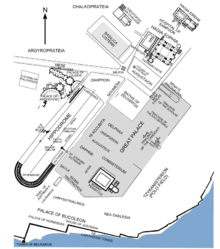


The Milion (Greek: Μίλιον or Μίλλιον, Mílion; Turkish: Milyon taşı) was a marker from which all distances across the Roman Empire were measured. Erected by Septimus Severus in the 3rd century AD in the city of Byzantium, it became the zero-mile marker for the empire upon the re-founding of the city as Constantinople in 330 AD. Thereafter, it would serve as the starting-place for the measurement of distances for all the roads leading to the cities of the Eastern Roman Empire. It thus served the same function as the Golden Milestone (Milliarium Aureum) in Rome's forum, erected by Augustus. The domed building of the Milion rested on four large arches and, over the centuries, it was expanded and decorated with several statues and paintings.[1] Though it had survived the sack of Constantinople in 1204 and the Ottoman conquest of Constantinople in 1453, it disappeared by the start of the 16th century in the Ottoman era.[2] During excavations in the 1960s, some partial fragments of the Milion were discovered under houses in the area.[2]